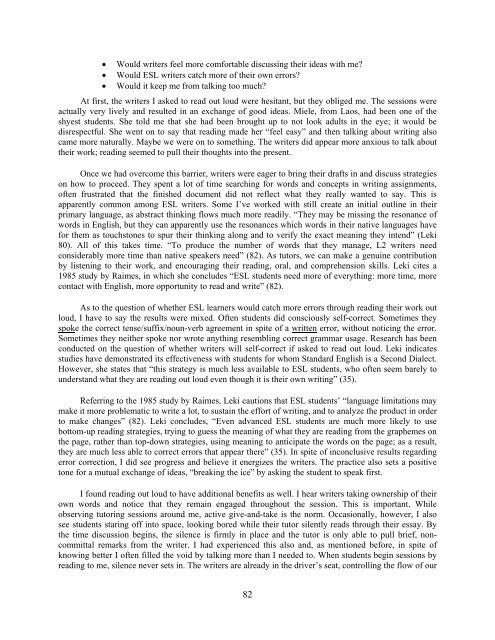The Tutoring Book - California State University, Sacramento
The Tutoring Book - California State University, Sacramento
The Tutoring Book - California State University, Sacramento
You also want an ePaper? Increase the reach of your titles
YUMPU automatically turns print PDFs into web optimized ePapers that Google loves.
• Would writers feel more comfortable discussing their ideas with me?<br />
• Would ESL writers catch more of their own errors?<br />
• Would it keep me from talking too much?<br />
At first, the writers I asked to read out loud were hesitant, but they obliged me. <strong>The</strong> sessions were<br />
actually very lively and resulted in an exchange of good ideas. Miele, from Laos, had been one of the<br />
shyest students. She told me that she had been brought up to not look adults in the eye; it would be<br />
disrespectful. She went on to say that reading made her “feel easy” and then talking about writing also<br />
came more naturally. Maybe we were on to something. <strong>The</strong> writers did appear more anxious to talk about<br />
their work; reading seemed to pull their thoughts into the present.<br />
Once we had overcome this barrier, writers were eager to bring their drafts in and discuss strategies<br />
on how to proceed. <strong>The</strong>y spent a lot of time searching for words and concepts in writing assignments,<br />
often frustrated that the finished document did not reflect what they really wanted to say. This is<br />
apparently common among ESL writers. Some I’ve worked with still create an initial outline in their<br />
primary language, as abstract thinking flows much more readily. “<strong>The</strong>y may be missing the resonance of<br />
words in English, but they can apparently use the resonances which words in their native languages have<br />
for them as touchstones to spur their thinking along and to verify the exact meaning they intend” (Leki<br />
80). All of this takes time. “To produce the number of words that they manage, L2 writers need<br />
considerably more time than native speakers need” (82). As tutors, we can make a genuine contribution<br />
by listening to their work, and encouraging their reading, oral, and comprehension skills. Leki cites a<br />
1985 study by Raimes, in which she concludes “ESL students need more of everything: more time, more<br />
contact with English, more opportunity to read and write” (82).<br />
As to the question of whether ESL learners would catch more errors through reading their work out<br />
loud, I have to say the results were mixed. Often students did consciously self-correct. Sometimes they<br />
spoke the correct tense/suffix/noun-verb agreement in spite of a written error, without noticing the error.<br />
Sometimes they neither spoke nor wrote anything resembling correct grammar usage. Research has been<br />
conducted on the question of whether writers will self-correct if asked to read out loud. Leki indicates<br />
studies have demonstrated its effectiveness with students for whom Standard English is a Second Dialect.<br />
However, she states that “this strategy is much less available to ESL students, who often seem barely to<br />
understand what they are reading out loud even though it is their own writing” (35).<br />
Referring to the 1985 study by Raimes, Leki cautions that ESL students’ “language limitations may<br />
make it more problematic to write a lot, to sustain the effort of writing, and to analyze the product in order<br />
to make changes” (82). Leki concludes, “Even advanced ESL students are much more likely to use<br />
bottom-up reading strategies, trying to guess the meaning of what they are reading from the graphemes on<br />
the page, rather than top-down strategies, using meaning to anticipate the words on the page; as a result,<br />
they are much less able to correct errors that appear there” (35). In spite of inconclusive results regarding<br />
error correction, I did see progress and believe it energizes the writers. <strong>The</strong> practice also sets a positive<br />
tone for a mutual exchange of ideas, “breaking the ice” by asking the student to speak first.<br />
I found reading out loud to have additional benefits as well. I hear writers taking ownership of their<br />
own words and notice that they remain engaged throughout the session. This is important. While<br />
observing tutoring sessions around me, active give-and-take is the norm. Occasionally, however, I also<br />
see students staring off into space, looking bored while their tutor silently reads through their essay. By<br />
the time discussion begins, the silence is firmly in place and the tutor is only able to pull brief, noncommittal<br />
remarks from the writer. I had experienced this also and, as mentioned before, in spite of<br />
knowing better I often filled the void by talking more than I needed to. When students begin sessions by<br />
reading to me, silence never sets in. <strong>The</strong> writers are already in the driver’s seat, controlling the flow of our<br />
82

















